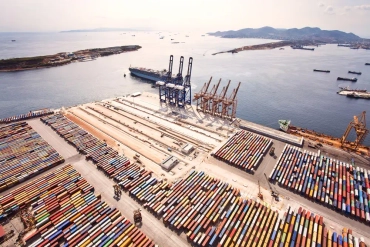
Top ports in South America



Top ports in South America
When discussing the ocean freight industry, hardly anyone ever mentions South America. Not a single carrier in the top 20 shipping lines are from South America. Not even the top 30.. Straddling the Atlantic and Pacific Oceans, that seems rather bizarre. Furthermore, none of the South American ports feature in the top 20 ports in the world. You’d have to go down to 38th place to find the first South American representative - Santos Port in Brazil.
We cannot, however, ignore the importance of South America to the shipping industry, especially when looking for competitive container shipping rates. Routes going to and from South America represent 15% of the total number of trade services. Plus, we mustn’t forget that it is, after all, home to the Panama Canal. A key conduit for international maritime trade, the canal’s locks underwent an expansion in 2016 to receive the ever-increasing vessels and megaships.
2015 performance
In 2015, ports in South America recorded a 1.7% growth in containerized cargo movement. According to data released by the Economic Commission for Latin America and the Caribbean (ECLAC), this represents a 0.8% growth from 2014. While figures are in the green, it’s still representative of the slowdown the industry is witnessing. Comparatively, in 2012, the region recorded a 5.9% growth. The slowdown was attributed to a fall in port activities in Brazil, Peru, Puerto Rico, Trinidad & Tobago and Venezuela.
Thus said, the relatively low 1.7% growth reflects two trends: the lack of foreign trade by container terminals and the diversity of growth rates within the region.
In total, the region handled 48 million TEUs in 2015, of which the top 20 ports handled 32.5 million (67.7%).
Here’s an infographic on the top ports in South America in 2015. [Infographic credit: ECLAC]
![]()
Top 5 ports in South America
1. Santos, Brazil (3,645,448 TEUs)
Located in the city of Santos in Brazil’s Sao Paolo state, Santos Port has reigned as South America’s busiest port since 2006. It’s also the area’s largest port and is one of Brazil’s most modern ports. Its strategic location allows easy access to the hinterlands via the Serra do Mar mountain range.
Up until the second world war, coffee made up Sao Paolo’s largest exports. Today, main exports include cars, machinery, soybeans and orange juice.
2. Colón, Panama (3,577,427 TEUs)
Panama’s Colón Port is located right on the Atlantic side of the Panama Canal. It’s part of the country’s Colón Province, Panama’s second city.
Founded in 1850, the city of Colón served as a fast route to California during the Gold Rush. Originally on the Manzanillo Island, a marshy area, it was connected to the mainland via a railroad. Authorities also drained the marsh to allow for the construction of buildings.
3. Balboa, Panama (3,294,113 TEUs)
The western sister of Colón Port, Balboa Port is located on the Pacific side of the Panama Canal. The US founded it during the construction of the Panama Canal.
Balboa Port has a Panamax-sized dry dock with gates similar to the Panama Canal’s locks. The Panama Canal Railway connects Colón Port and Balboa Port, and allows container transportation via train.
4. Cartagena, Colombia (2,606,945 TEUs)
Colombia’s Port of Cartagena is located on the country’s northern Carribean shores. It’s Colombia’s main oil port and an important export point for coffee and platinum. The port is home to tobacco and sugar producers and is largely utilized by cosmetics, fertilizer, textiles and leather goods manufacturers.
A little tidbit about the port: Along with its fortress and other monuments, UNESCO recognized the Port of Cartagena as a World Heritage Site in 1984.
5. Manzanillo, Mexico (2,458,135 TEUs)
Manzanillo Port holds the honor of Mexico’s busiest port for Pacific cargo for the Mexico City area. Located in the Mexican state of Colima, the city plays an important role in the business and tourism sectors.
Opened in 1925, authorities named the port after the abundant Manchineel trees native to the region. Incidentally, these trees were common material for shipbuilding back in the early days.
Related Articles


